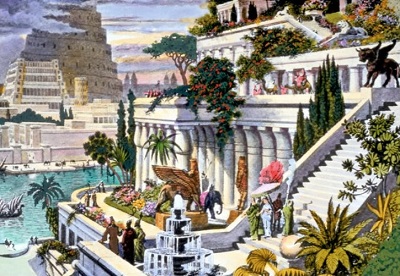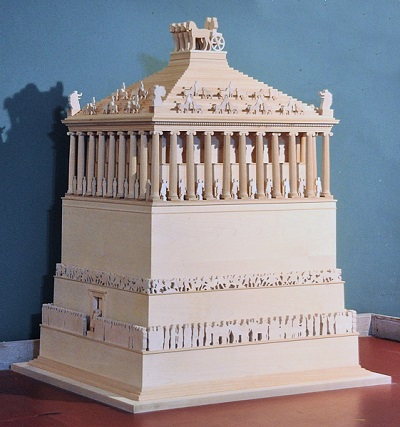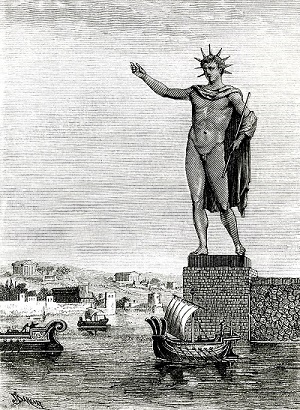The seven wonders of the ancient world represent seven remarkable constructions that were popular among the ancient Greek tourists. The first list of the seven wonders dates back to 2nd century BC. Antipater of Sidonis associated with the seven wonders which he described in a poem written about 140 BC. It changed as the time passed and during the renaissance the current list of seven wonders was confirmed. The number seven was chosen as ancient Greeks believed that the number represented perfection and plenty, and because it was the number of the five planets known anciently, plus the sun and moon. Let’s look at the seven wonders of the ancient world.
01. The Great Pyramid of Giza

It was build during 2584–2561 BC by the Egyptians in Giza. It is the oldest of the seven wonders. The historians believe that the pyramid was built as a tomb for the Fourth Dynasty Egyptian pharaoh Khufu and estimate that it might have taken 27 years to built it. Initially standing at 146.5 metres (481 feet), the Great Pyramid was the tallest man-made structure in the world for more than 3,800 years. Throughout history the majority of the smooth white limestone casing was removed, which lowered the pyramid’s height to the present 138.5 metres (454.4 ft). What is seen today is the underlying core structure. The base was measured to be about 230.3 square metres (755.6 square feet) , giving a volume of roughly 2.6 million cubic metres (92 million cubic feet).
02. Hanging Gardens of Babylon

The hanging gardens of Babylon is a structure of a building which believed to be built in 600 BC. The existence of the garden is still doubted as it has been destroyed completely during the 1st century AD. Only few documents have found that clearly mention the garden. To date, no archaeological evidence has been found at Babylon for the Hanging Gardens. According to literature that described the garden featured blossoming flowers, ripe fruit, burbling waterfalls and terraces exuberant with rich foliage.
03. Temple of the Artemis

The temple of Artemis was build by the Greeks during 550 BC. It was a Greek temple dedicated to Artemis, the goddess of the hunt, the wilderness, wild animals, the Moon, and chastity. The goddess Diana is her Roman equivalent. Therefore the temple is also known as Temple of Diana. It was destroyed in 356 BC by Herostratus, who burned down the temple. In 323 BC the temple was rebuilt. But again in AD 262 the temple was destroyed by Goths, a Germanic tribe. Today the foundation and few stones that used to build the temple could be seen at the site.
04. Statue of Zeus at Olympia

The statue of Zeus was a giant seated figure of Zeus, located in the temple of Zeus. The temple was built in between 466–456 BC and the statue was built in 435 BC. It was about 12.4 m (41 ft) tall. The statue was lost and destroyed during the 5th century AD. Details of its form are known only from ancient Greek descriptions and representations on coins. Some believe that after the Christian Roman emperor Theodosius banned worshiping and participation in any pagan cults the temple of Zeus was ignored and the statue was Disassembled and reassembled at Constantinople and it was destroyed by the great fire at Palace of Laususin in 475 AD.
05. Mausoleum at Halicarnassus

Mausoleum at Halicarnassus or the Tomb of Mausolus was a tomb built between 353 and 350 BC in Halicarnassus (modern day Turkey). It was approximately 45 m (148 ft) in height. It was destroyed by successive earthquakes from the 12th to the 15th century.
06. Colossus of Rhodes

Colossus of Rhodes was a statue of the Greek sun-god Helios, erected in the city of Rhodes, on the Greek island of the same name, by Chares of Lindos in 280 BC. it was constructed to celebrate the successful defence of Rhodes city against an attack by Demetrius Poliorcetes, who had besieged it for a year with a large army and navy. The statue was 33m tall in height, which is almost as tall as statue of Liberty is USA. It was collapsed during an earthquake 226 BC.
07. Lighthouse of Alexandria

Lighthouse of Alexandria was built during 280–247 BC and was estimated to be at least 100 metres (330 ft) tall. The legend says that the lighthouse was built to guide the ships to the ports because the people lived in that land (island of Pharos) were famous to take the valuables (wreckers) after ship is destroyed. The lighthouse was severely damaged by three earthquakes between 956 AD and 1323 and became an abandoned ruin. It was the third-longest surviving ancient wonder (after the Mausoleum at Halicarnassus and the extant Great Pyramid of Giza), surviving in part until 1480, when the last of its remnant stones were used to build the Citadel of Qaitbay on the site.
I hope that you enjoyed reading these fantastic information on ancient history. Thank you for reading and for further facts please subscribe to my news letter. ❤


